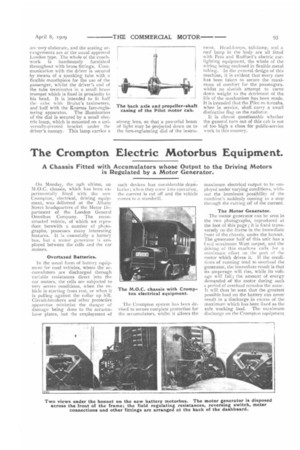The Pilot Motoreabi
Page 2

Page 3

If you've noticed an error in this article please click here to report it so we can fix it.
A Coventry-built Machine, of which a Number is Shortly to be Stationed in the West End of London.
A new design of motorcab, which is to be known as the " Pilot," has this week been submitted for licensing to the authorities of the Public Carriage office at Scotland Yard. A small fleet of ten similar machines will eventually be stationed at the premises occupied by Motor Schools, Limited, Heddon Street, W., whose managing director, Mr. Turberville Smith, has been responsible for the general design and specification of this new vehicle. The garage for these cabs is now being prepared in the capacious basement at that address, and access to it is obtained by means of an electrically-propelled lift—a novel arrangement for public-service work.
We have been afforded an opportunity to inspect the first machine of this new type. It has just been delivered from the works of West, Limited, of Coventry, where the rest of the fleet is rapidly nearing completion. The chassis is of particularly robust construction, and it is evident that the designer has had the intention to produce a machine which shall not possess those weakly tendencies that are so noticeable on many of the lighter builds of rnotorcabs which arc at present running in London.
A special pattern of White and Poppe four-cylinder engine is em ployed. The cylinders are cast in pairs. They have a bore of 85mm., and the pistons have a stroke of riorran. The engine builders state that the normal speed of this motor is 1,360 revolutions. At this high rating, it is quoted as giving 2113.h.p. The valves, of course, are all mechanically
camshafts. Water circulation has been arranged on the thermo-syphon system, and the radiator is of ample size and of the Albany cellular type. An interesting feature of the engine is the means which are adopted to secure the mounting of the magneto in an accessible position. In the Pilot cab the magneto is fixed so as to be accessible from the driver's side of the dashboard. The drive to this component is secured by an overhead layshaft, and this is driven, at the front end of the engine, by an inclined skew gearshaft, which is entirely encased. Provision is made for the fitting of a dual system of ignition if it is eventually thought wise to adopt such a course, but at present reliance is placed on the single system of hightension magneto with a Bosch dynamo.
Considerable care has been taken with the planning of the lubrication system; an oil tank is carried on the near side of the engine under the bonnet, and from it a small gear-driven pump forces the lubricant into the crank chamber, and thence to the various bearings in the manner
adopted by White and Poppe on their previous engines. Advantage is taken of the provision of the overhead magneto shaft for the fixing of the fan thereto at the front end. The carburetter and silencer are both White and Poppe specialities, and the construction of these details is, no doubt, quite familiar to our readers. The clutch is of the standard Hele-Shaw multi-disc type. The gearbox has three speeds forward and one reverse, with a direct drive on top speed, and all the gear shafts are mounted on ball bearings.
Particular attention has been paid to the construction of the back axle, of which we reproduce a photograph herewith. The road wheels revolve on extensions of the casing, and these latter are made from hollow steel forging-s. The flanges by which they are secured to the centre easing are formed out of the tubes themselves. Special provision has been made for the lubrication of the universal joint to the propeller shaft. We illustrate this substantially-designed component on this page. Two independent svsterns of brakes are fitted; that on the propeller shaft is of the band type, and
is of unusually large dimensions, whilst the rear-wheel brakes are of the internal-expanding pattern. It is intended to fit the road wheels of all the fleet with the well-known " pneumatic tires. The body work and coach fittings are very elaborate, and the seating arrangements are of the usual approved London type. The whole of the coachwork is handsomely furnished throughout with brass fittings. Communication with the driver is secured by means of a speaking tube with a flexible mouthpiece for the use of the passenger, whilst the driver's end of the tube terminates in a small brass trumpet which is fixed in proximity to his head. It is intended to fit half the cabs with Bruhn's taximeters, and half with the Kosmos fare-regis tering apparatus. The illumination of the dial is secured by a small electric lamp, .which is mounted on a universally-pivoted bracket under the driver's canopy. This lamp carries a strong lens, so that a powerful beam of light may be projected down an to the fare-registering dial of the instru ment. Head-lamps, tail-lamp, and a roof lamp in the body are all fitted with Peto and Radford's electric carlighting equipment, the whole of the wiring being enclosed in flexible metal tubing. In the general design of this machine, it is evident that every care has been taken to secure the maximum of comfort for the passengers, whilst no slavish attempt to carve down weight to the detriment of the life of the mechanism has been made. It is intended that the Pilot motorcabs, when in service, shall carry a small distinctive flag on the radiator.
It is almost questionable whether the general turn out of this cab is not of too high a class for public-service work in this country.


















